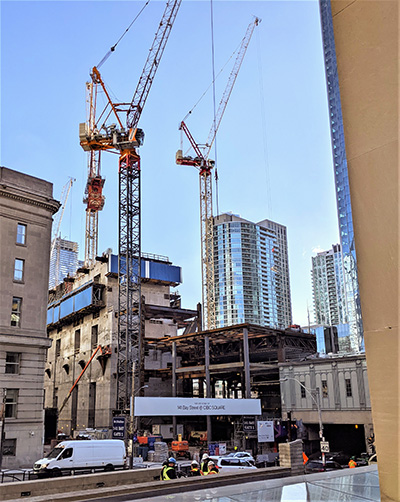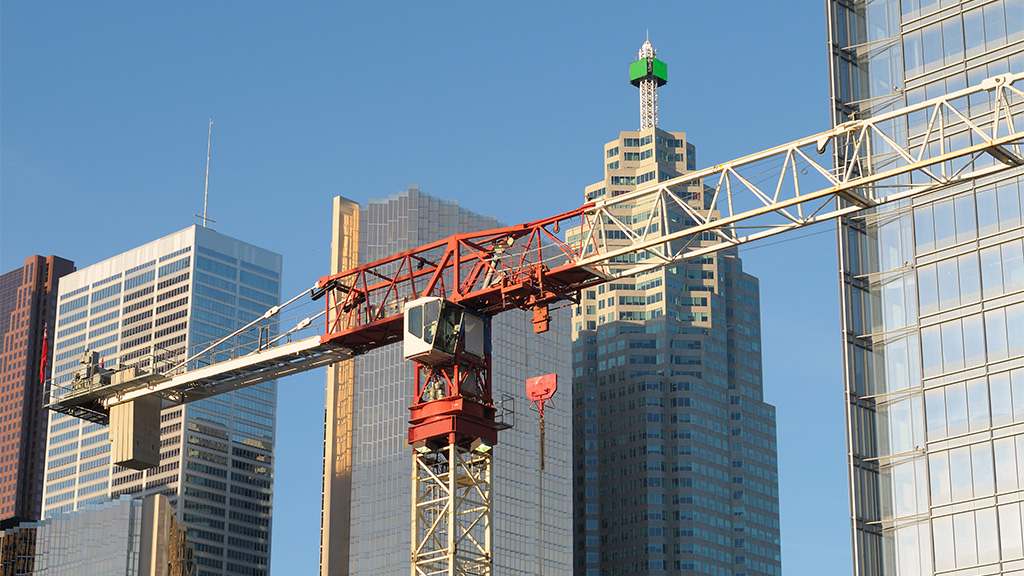Toronto is again tops in North America in the latest Rider Levett Bucknall (RLB) Crane Index but with headwinds continuing to buffet the construction sector in Ontario, the question emerges: how long will it last?
The Q1 count of construction cranes in the skies of 14 North American cities revealed Toronto’s biannual dominance in the count continues. RLB reported April 10 that the Toronto skyline had 238 cranes, far surpassing Seattle, which has 51 cranes, Los Angeles, with 47, and Denver, 36.
Toronto also led the pack by a large margin in Q3 2022 with 230 cranes and there were 252 counted in Q1 2022.
Residential cranes dominated but even removing Toronto’s 139 cranes at residential sites, the Ontario capital still had almost double Seattle’s overall total. RLB counted 35 cranes at Toronto commercial projects, 33 at mixed-used projects, 10 at hospitality, seven at educational projects and six at public/civic jobs.
University of Toronto geography and planning professor Matti Siemiatycki, the director of the Infrastructure Institute, said Toronto’s dominance can be attributed to investor and owner confidence in the city.
Mel Yungblut, head of the Toronto RLB office, said the Ontario government led by Doug Ford is known to be pro construction and infrastructure, reducing uncertainty among developers, and added the City of Toronto is having success in expediting approvals after the city had long ranked poorly in world permitting statistics.
“I think it’s incredible the confidence that people continue to have in this market and in sectors that have struggled in recent years, where there have been real question marks, like office space and commercial real estate and retail,” said Siemiatycki.
RLB conducted the survey during the month of February in the 14 cities where it has offices.
“It was really interesting to us because we were expecting to see a little bit of a downturn on the residential side because the residential crane count makes up about over 60 per cent of the total cranes in the city,” said Yungblut of the Toronto tally. “So with all that rumbling post-COVID and during COVID that things were starting to downturn, the interest rates were coming up, we sort of expected the crane count was going to drop.”
It wasn’t the case that the residential cranes were employed on jobs that were three or four years old, Yungblut said.
Rather RLB visited each site and noted 31 cranes had come down from completed projects but there were another 37 that had gone up on residential sites.

A singular Toronto strength is its attractiveness to immigrants, Yungblut and Siemiatycki said, so much so that it counters constraints such as high construction costs, the workforce shortage, high interest rates and costly land.
Yungblut suggested there might be a hesitation seen in overall project starts in 2024 reflecting recent uncertainty but rising immigration, with the federal target now set at 500,000 nationally to take effect in two years, should ensure the Toronto construction sector will remain a going concern.
“The active ones in the city will continue to be active,” he said. “That is one observation that we do see. And they do need to turn over volume. As they earn the money they like to buy the next piece, keep the money flowing.”
Yungblut said clients have been telling RLB they are gaining confidence in the ability of Ontario’s workforce to supply the labour needed for a large project pipeline. They say Ontario’s Ministry of Labour is taking the right steps to assist in the recruitment of the next generation of skilled workers.
“They’re doing homework on the labour side to make sure they can get the skilled trades they need,” said Yungblut of prospective investors.
Siemiatycki acknowledged some developer concerns but noted changes to planning policy to reach housing targets are making development easier, “so there are countervailing forces at play here.”
It is known there are significant sites where permits have been approved but construction hasn’t started, Siemiatycki said, so that’s an issue as observers wonder when those projects will be unlocked.
Another concern is the type of housing that is being built, he said — in tough times rental projects tend to fall by the wayside first due to the delayed payoff for developers.
“We need to make sure that we’re both building the aggregate number of units but also matching the supply with what’s really needed,” he said, suggesting there is not an adequate plan for affordable homes.
“There’s a need to accelerate the pace, that’s really the story, is that at the same time as you see all these cranes in the sky, we need to meet the housing targets of 1.5-million homes for the province.”
Follow the author on Twitter @DonWall_DCN










Recent Comments